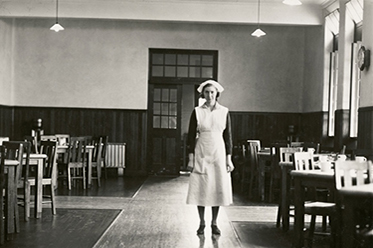 Exploring the social history of Bundoora Homestead as a Repatriation Mental Hospital for returned servicemen from 1920 until 1993, Coming Home tells a story of state and national significance, revealing elements of a little known chapter in the care and management of veterans suffering from mental disorders as a result of their war service.
Exploring the social history of Bundoora Homestead as a Repatriation Mental Hospital for returned servicemen from 1920 until 1993, Coming Home tells a story of state and national significance, revealing elements of a little known chapter in the care and management of veterans suffering from mental disorders as a result of their war service.
Coming Home features artefacts, artworks and personal stories from a wide variety of private and public collections, including historical photographs from the National Archives of Australia, Australian War Memorial, Red Cross and City of Darebin Art and History Collection.
After the First World War (1914 – 1918), the Commonwealth Government identified Bundoora Park estate, a 1890s Queen Anne style federation mansion and its grounds, as a suitable site for a Convalescent Farm. In 1924, the site became the Bundoora Repatriation Mental Hospital and was the first psychiatric facility established in Victoria to provide on-going care and rehabilitation for veterans with an accepted psychiatric illness due to their war service.
Labelled as ‘War Derelicts’, ‘Neurasthenic Soldiers’, ‘Shell-shocked’ or suffering from ‘Anzac Nerves’, little was understood about disorders known today as P.T.S.D. (Post Traumatic Stress Disorder) or other conditions resulting from trauma.
Significantly, in 1948 at Bundooora, senior medical officer and psychiatrist Dr John Frederick Joseph Cade AO (1912 – 1980) conducted research which led to his discovery of the successful effects of using lithium carbonate as a mood stabiliser in the treatment of bipolar disorder (then known as manic depression).
An important relationship featured in the exhibition is that of Sergeant Henry ‘Lofty’ Cannon, a long term patient at Bundoora. He was a medical orderly with the 2/9 Field Ambulance and Changi prisoner of war, who nursed Ronald Searle (1920-2011), renowned British artist and satirical cartoonist while working on the Thai-Burma Railway. Searle perilously documented this period, which included drawings of Lofty and the brutal camp conditions.
Coming Home also tells the stories of a number of significant military personnel associated with the City of Darebin including Able Seaman William Williams, the first recorded Australian service fatality for the First World War, Victoria Cross winners Sergeant William Ruthven (WWI) and Private Bruce Kingsbury (WWII) and Corporal Rodney Breavington, a Changi POW who was executed in the Second World War.
Coming Home
Bundoora Homestead Art Centre, 7 – 27 Snake Gully Drive, Bundoora
Exhibition: 3 October – 7 December 2014
Free entry
For more information, visit: www.bundoorahomestead.com for details.
Image: Bundoora Repatriation Mental Hospital Ward Dining Room, c 1930s
